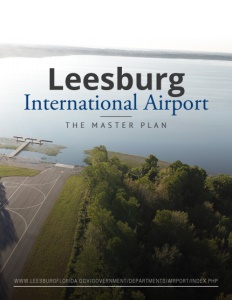Leesburg International Airport
The master plan
Business View Magazine interviews Tracey Dean, Airport Manager, at the Leesburg International Airport, as part of our focus on American regional airports.
Leesburg International Airport, located 35 miles northwest of Orlando, is the central hub for air transportation and business in Lake County, Florida. The airport was originally constructed in 1942, by the Civil Aeronautics Administration as a World War II training facility for the U.S. Army. In 1946, it was deeded to the City of Leesburg for use as a general aviation airport. It remained relatively small, after the war, and only began growing in the mid 1970s and early ‘80s, slowly becoming the major economic engine that it is today, with an annual impact to the Leesburg region of approximately $64 million.
With two runways extending up to 6,300 feet, the airport regularly supports flight training, corporate/ business operations, general aviation, aircraft charters, and recreational/sport flying, logging approximately 60,000 operations, per year. Tenants providing services include Brainerd Helicopters, a helicopter charter company; Skybolt, a manufacturer of aerospace fasteners; Wipaire, an aircraft maintenance and modification business; Flying Colors of Leesburg, an aircraft painting business; Sunair Aviation, the Airport’s fixed base operator; Central Florida Avionics & Instruments; Av-Mech Mechanics; Aerostat, Inc., aerial and firefighting equipment. Also located at Leesburg are, Angel Flight, a humanitarian nonprofit organization of more than 650 volunteer pilots; Lake County Sheriff’s Aviation Unit; The Civil Air Patrol – Lake Composite Squadron; Experimental Aircraft Association – Chapter 534; and The Villages retirement community’s corporate flight department.
In addition, Leesburg International Airport is a Port of Entry to the U.S., due to its U.S. Customs and Border Protection office, allowing international flights to be cleared in Leesburg and the establishment of a Foreign-Trade Zone. The airport, which is managed by the City of Leesburg, is self-sustaining, and has been designated a Gold Seal Airport by the Florida Department of Transportation, recognized for its high standards for infrastructure, services, and safety.
The most recent, major project at the airport has been the construction of a seaplane ramp and associated docks. “The seaplane ramp is complete,” says Airport Manager, Tracey Dean. “And every person that’s used it has commented they think it’s the most beautiful seaplane facility they have ever seen and used.” The State of Florida is second only to Alaska in terms of the number of seaplanes and seaplane-certified pilots that are registered within the state. The airport’s proximity to the Metro Orlando area, together with the availability of U.S. Customs services on the airfield, make it an ideal gateway for seaplane traffic to the Central Florida region. Leesburg’s sister city, Tavares, located about 11 miles to the east, is a local hub for seaplane sightseeing and entertainment, and the Leesburg Airport is expected to serve as a hub for seaplane maintenance.
Currently, the Airport is in the progress of working through a comprehensive Master Plan, which, according to Dean, outlines its programs, operations, and potential growth through 2035. “The airport is about 850 acres, so there’s additional land for future development, but there are challenges that come with it,” she notes. “There’s a lot of wetlands on the property and there’s a need for infrastructure; there are no utilities on the south side. So, long-term, there is plenty of room, and, hopefully, the Master Plan will help us prioritize some of that.”
Within the Master Plan is the recognition that, with a waiting list of approximately 100, new hangars will have to be built for GA aircraft. “So, we are designing two buildings with five units, each, for individual storage for private pilots,” says Dean. “We’re sizing those bigger than the existing ones that we have; we’re trying to keep up with the demand. The Master Plan also identifies that, every other year, we need to build another building. The ones that we’re designing, right now, by the end of the calendar year, or the beginning of the next, should be complete. We’re shooting for the location of the most readily buildable land, because after we deplete that, then we really get into some of the wetlands, which is still available, it’s just that any construction project costs would be doubled because of mitigation costs.”
Another item addressed in the Master Plan is the potential construction of an access road to the southwest side of the property, because it is an area that Dean says is the next likely one to develop. “The FAA announced that, in addition to the regular entitlement and discretionary funding that they help airports with, they were adding additional money,” she reports. “They were asking airports to submit projects that would, typically, be considered for regular discretionary funding, but with a bit of a twist, because, maybe they weren’t the FAA’s highest priority for the airports. So, this would be something that they would consider funding at 100 percent construction costs, if the city was ready to go with a design, or have it designed in time for them to distribute funds. In the first round of three, they did not award any Florida airports. Hopefully, for Round Two, I have submitted this southwest access road with utility infrastructure for consideration, because any party that’s approached us, that needed a sizeable area of land and asked where they can build, when they find out about the mitigation and the wetlands, they’re usually turned off. So, if we were to get funding to build the access road and get the utility infrastructure, I think it would make it much more attractive for somebody to say, ‘I’d like to put my operations there and I’ll construct a hangar for that purpose.’ But, until we get a road and utilities in there, it’s not feasible that people are going to knock on the door. So fingers crossed.”
Future projects at the Airport also include the rehabilitation of its primary runway. “It is still in fair condition, but we’re trying to be proactive,” says Dean. “If we do it now, then it saves us from a full reconstruction, two to three years from now. The FAA and DOT are aware of the project and would both, likely, help with funding on that. That’s one of their highest priorities – maintenance of the airfield’s existing structures. Now, I have a negotiated contract with an engineering firm. That design could be done by the end of the calendar year, and then rehabbing the runway would be included in the next round of grants in late 2020.”
AT A GLANCE
WHO: Leesburg International Airport
WHAT: A city-owned, general aviation airport
WHERE: Leesburg, Lake County, Florida
WEBSITE: www.leesburgflorida.gov/government/departments/airport/index.php




